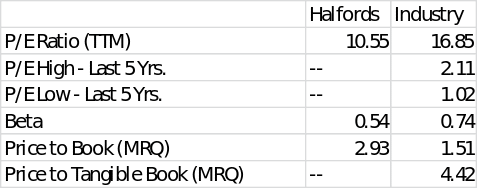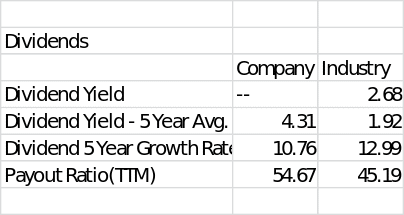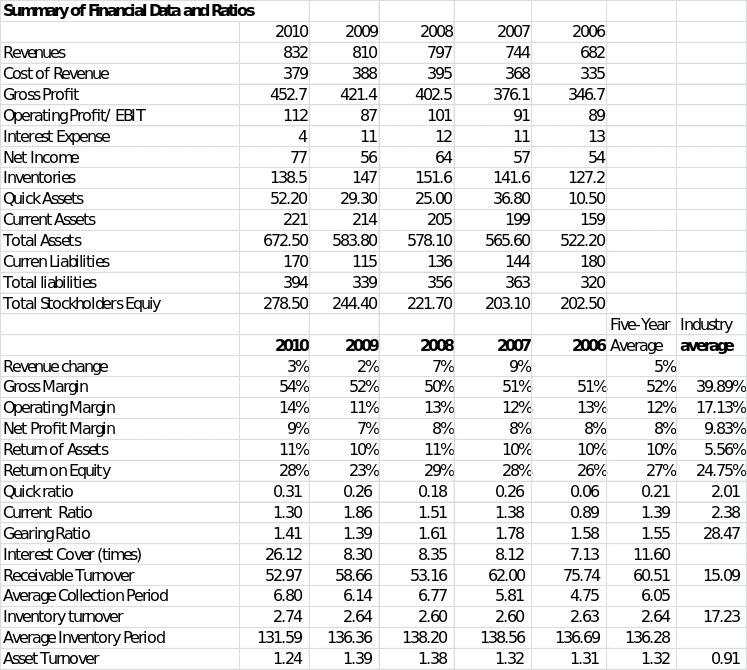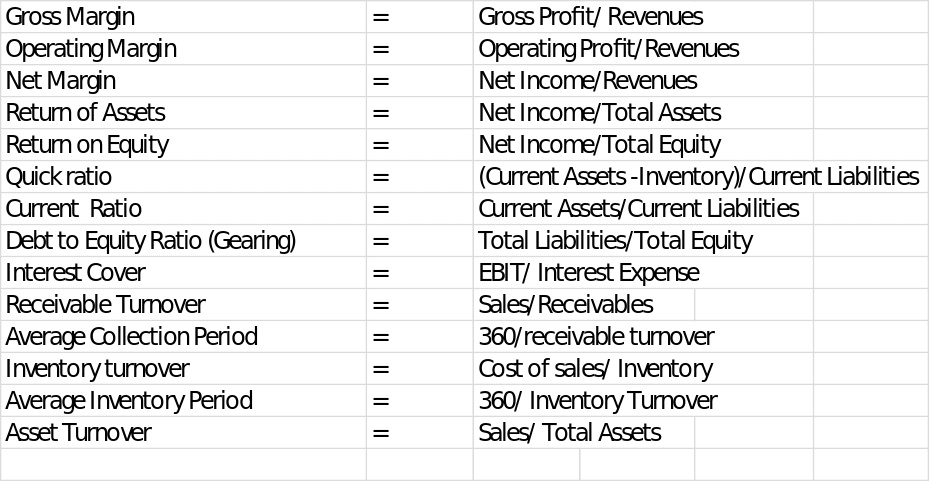Introduction
Objective of the Report
This paper seeks to analyze Halfords for purposes of possibly investing with the company’s stocks based on its annual reports including the financial statements thereto. This would therefore examine the financial statements of the company consisting of the consolidated income statements, consolidate statement of financial position and consolidated statement of cash flow. From the financial statements evaluation would extend to financial ratios of performance, liquidity and gearing for the last five years as against the industry. In addition, this researcher will evaluate Halfords’ market ratios and dividends conditions for the same period in relation to the industry.
Valuations would also be conducted to determine possible overvaluation or undervaluation of its stock. This will also consider the analysts’ estimate and projection on Halfords’ stock and determine where there is basis to rely on that information compared with valuation that would be produced in this paper.
Summary of Findings
Halfords was found profitable and its management-efficient. The same was consistent with further findings on the company’s liquidity and good gearing ratio indicated strong financial position of the company. Such findings are supported also by further finding of favorable market ratios, and impressive dividend ratios. Valuation made however contains proofs of possible overvaluation of its stocks that points to the recommendation to rather make the sale now for those who holds stocks than face the risk of overvaluation of its stocks.
Firm industry and environment
Firm Description
Halfords Group Plc (or “Halfords”) is into retail industry of vehicle, parts and service. It is known in U.K. for retailing of of auto, leisure and cycling products being its base. It It has a very extensive reach for its customers with not less than 430 stores inside and outside the UK. With not less than 20 stores overseas including that, Poland, of the Republic of Ireland and the Czech Republic, one can imagine how big the company is.
It operates in three product markets. It has car maintenance as the first market where the company makes available to customer consumables like batteries, car bulbs, wiper blades, batteries, car bulbs and oils driving. It second market I is on car enhancement products where it makes available to customers car cleaning products and in-car accessories. Its third market is on leisure sales which are essentially referring travel solutions under its cycling category where the company makes available to customer roof bards, tents, child seats, roof boxes, and cycle carriers.
Discussion of competitive environment
An industry normally consists of competing firms which vie for market share as they compete as well for profitability as afforded by industry. Porter (1985) talks of competitive strategies to be employed by different firms as their extract profitability in an industry. Halfords has its key competitors and they include Vertu Motors Plc., Inchcape Plc, Pendragon Plc. By ranking them in terms of their capitalizations Halfords comes second to Inchape among the four. Such ranking can indicate size and Halfords must indeed be big and serious player in the retail of auto parts and service industry.
Since the industry’ performance where Halfords compete is strongly correlated with performance of the economy, it may have to deal with characteristic of competitive pricing as any slowdown in the economy could mean more extensive rivalry of players as the latter would have to bid lower price in delivering value to customers, of they have to share in the market.
Economic climate and outlook
The company like many other companies of different industries operate better when the economy is good. Given therefore the status of the UK economy as still on verge of recovery from economic recession where unemployment appears still at a high level, the company’s prospects for more revenues may be considered in a still not so certain future. The sad situation in the economy will certainly is causing cost efficiency problems for many industry players. This must be causing moderate to low level of revenues which when translated at the corporate level could mean lower revenues and profits for Halfords and other players in the industry.
This same reason was the triggering cause for Halfords to close its seven Central European stores. The company went it its reviewed revealed lack of attractiveness basically attributable the frail markets and as serious difficulty in locating sources for its sites.
The company chairman could only have assessed the trading environment to be still very much challenging. In other words, managing sales revenues to a more advance level would still be tough in the future. Developments from the change in the government of the United Kingdom that is facing reduced public spending would be particularly adding to the challenge of the company’s future.
Evaluation of financial statements
The financial statements which are subject of evaluation pertain to last five years and they summarized in Appendix A. The figures came from the three basic financial statements in the Annual Report. They include those from balance sheet, income statement and the cash flow statements.
Analysis of Financial Statement with Ratios
Analysis of the accounts could come more meaningful by relating one account with rest and afterwards derived their ultimate effects on profitability, efficiency, liquidity and gearing or capital structure of the company.
Profitability and Management Efficiency
By looking at what happened in the last five years, Halfords’ profitability can be considered as highly profitable. From the five-year average of its return on equity (ROE) at 27% one can already infer a great advantage of possibly choosing the company as an investment option. If compare with the competitors in the industry, a clear superiority about its past performance is very much evident given that the industry average just had 24.75%. Contemplating an average about 27% return on equity when the economy is not doing well, would already be a rare chance to have. In practical sense, it would mean that a company or an investor putting 100 British pounds in investment could expect returns of about 27 pounds in return. See Appendix A for more details.
The computed return on equity for Halfords necessitated dividing net profit to the total stockholders’ equity or shareholders’ funds. The ratio therefore indicates a relation how much income or earning any right thinking investor may get from the investments they put into the company. It is thus normal to view ROE to an average rate earning that an investor may get by just waiting from his or her earnings from a risk-free investment like keeping money in treasury bills where a less risk is expected as government can normally pay without too much risk for the investor. Thus the more than 20% ROE as against 0.50% based Bank on England base rate (Housepricecrash, 2010) would be bonanza for an investor. Such profitability of Halfords could speak of the quality of management that company has for stockholders.
Management’s efficiency which could speak for capacity of management to deliver results may be more finely determined and evaluated using another ratio. Measuring the latter, is also possible under return on assets (ROA), where Halfords five-year average of 10% was is Manifestly higher than the industry average of 6%.
The earlier determined better profitability and efficiency than industry for Halfords becomes more objective if viewed with whether average net operating margin and net profit margin are pointing the same thing. Thus the resulting operating profit margins for the last five years have an average of 12% which is slightly lower than the industry average of 17.13%. This means that company has spent on the average more operating expenses than competitors in relation to total revenues.
Bring the decision to the bottom line ratio on the net profit margin and a lower average net profit margin of the company than the industry came out. With such seeming conflict between its relative position as to efficiency and profitability, other related ratios could be used.
Further analysis revealed Halfords to have higher gross margin but finally resulted to lower rates for its operating margin then followed by net profit margin. Investigating receivable turnover, inventory turnover and asset turnover showed that Halfords has lower inventory turnover. However, more favorable receivable turnover and asset turnover came about. Thus, it can more specifically declared that the company has less efficiency inventory aspect in all other aspects there is stronger evidence to sustain higher efficiency of the company as against the industry. See Appendix A.
Liquidity
A company’s liquidity is very important for purposes of knowing whether such a financial health to survive has. The consequence of lack of it makes one to fold out of business simply because employees are not paid on time and suppliers are effectively discourage to lend goods and services to company so that it can have something to sell to customers. For a company to show liquidity it must be capable to pay its currently maturing obligations. Current ratio and the quick asset ratio measures liquidity a a resource capability. In the case of Halfords, Appendix A gives the summary for the details.
From Appendix A, Halfords’s average current ratio showed 1.39 as against industry average of 2.38. Comparison showed a clear profit that it is better than competitors. By dividing current assets to current liabilities, current ratio can be solved. To further proof is advantage in liquidity; the quick assets ratio just can be applied. Compare with current ratio, the quick ration is stricter as the inventory and prepaid expenses are removed from the current assets before dividing the same to current liability.
This makes quick asset ratio to measure more superbly than the current ratio. Halfords’ quick ratio was reflected at 0.21 compare with industry average of 2.01. The company has notably lower liquidity ratio than average competitors but its current ratio is still high at above 1.0 hence, it can still be considered as liquid. Having too high liquidity may not be good because it could mean idle funds.
Gearing Ratios and Capital Structure
Apart from having good liquidity is need to have good gearing ratio or solvency or financial leverage. Such position should indicate a company’s long-term capacity to keep up it steadiness over the long term. Since the same can measured by the debt to equity ratio, by relating or dividing the total debt of the company to its total equity or total shareholder funds, said gearing if good will promise investors that Halfords is not just to endure the short term. The company can live a long life that it can withstand a temporary “tsunami” or financial storm like a crisis that was experience in the US until this time starting 2007. Having the life to withstand temporary setback is the indeed the sigh of one that has good stable condition.
Halfords’ debt to equity ratio is 1.55 which very much superior as against industry average of 28.47. See Appendix A. Said financial level more just simple double indicative of strength that does not collapse with temporary economic crisis. It also indicates stockholders’ willingness and attitude to face risk in the face of its creditors who entrust to them the latter’s financial resources for them to be managed well while the company is alive.
Halfords can convince its investors with its evidence of a good leverage capital structure. As if it is saying that it can securely make further expansions in the future without fear that I may become riskier as present competitors now suffer. It is showing of capacity to manage risk and to weather the financial storms that may come along the way as part of real world of business. See Appendix A.
Market ratios
Market ratios of Halfords can be compared with the industry. The same can tell valuation of the stocks of Halfords under the theory of the efficient market. Management maximizes value or stockholders’ wealth of the latter including their own and market ratios may provide some intimation. Investors willingness to take risk as they invest with company given the latter’s level of earnings can be determined. Table A below summarizes the market ratios for Halfords as against is competitors in the industry. Halfords P/E ratio for the past trailing months of 10.55 as against industry average of 16.85 may mean an undervaluation similar companies may appear to be trusted more.

Dividend Ratios
Halfords indicated capability to satisfy the need of its stockholder for their dividends needs based on Table B below. The noticeable decision of Halfords from the yield ratios and payout ratios shown in Table B below indicates a clear dividend policy with a promise of continuity a commitment to provide with determination. This could indicate building a long-term relationship since investors are taken cared of to be compensated well as the company delivers financial performance. This is notable and appears possible given the good capital structure of the company based on its gearing as earlier discussed.

Valuation of Halfords stocks
Weighted cost of capital for Halfords
Valuing the stocks of the company should give some information whether the stock market reflects the real value of the company and it could serve as a guide to determine possible undervaluation or overvaluation using intrinsic value as the more objective information. Before such a valuation of the stocks could be done a company’s cost of capital should be determined since such would be used in discounting the expected value from the company which will be expected to operate for the years to come as a going concern.
The said cost of capital is analogously compared to the opportunity cost concept in economics where every decision or choices made presupposes an alternative. In simple question, the issue of cost of capital could be posed this way: Would the investor have earned better if it has placed its investment other than with Halfords? The estimate of such cost of capital can be started by applying CAPM model. The formula is: Required (or expected) Return = RF Rate + (Beta * (Market Return – RF Rate)), where RF stands for risk free rate and the rest of the formula is the market risk premium. Halfords would have a cost of capital at 3.43% if the formula is applied as follows: Required (or expected) Return = RF Rate + Beta (Market Return – RF Rate) =.50% + 0.54 (5.93%-0.50%) = 3.43%.
Valuation Proper
Valuation is possible now be done after the cost of capital got estimated. There are many methods of valuation from a variety of literature that has developed thru the years. This paper uses only the constant growth dividend model which assumes that dividends given to stockholders are assumed to be constant or and expected to grow over the years.
This model now starts the use of the cost of capital as estimated earlier at 3.43% using the CAPM. The market value per share of Halfords could be derived by using the formula where the dividend or numerator of the formula is Do(1+g) and the divisor or denominator of the same formula is Ks-g. Do(1+g) include values where the variable means as follows: Dividend last year or Do and expected growth rate in dividends or (g).
The part of the formula Ks-g would, Ks as the discount rate and g with same meaning as in the dividend. Thus the value of £47.91 is computed by manipulating the following information: The dividend per share paid latest year (2010) is given at £0.20 from the financial statements, while the expected growth rate was derived by taking the average increase of the dividend for the years. Finally the growth rate was assumed at 3% to allow the working of the constant growth dividend discount model, since to have it bigger than the low 3.43% as computed would make the formula not applicable. Comparing now the computed intrinsic value of £47.91 with Halfords’ stock as appearing in the stock market at £366.7 per share an overvaluation must be in order.
Conclusion
Halfords has all the proof of high profitability and good management efficiency. Combining the same with the acceptable liquidity and good gearing ratio that the company also have are justifiable basis for making investments with company. To have profitability and efficiency can hold the promise or strong logical connection for better expectation that a company may improve or maintain the good liquidity.
The same should keep Halfords stable by maintaining or further improving its already good leverage position. Halfords’ lower PE ratio may mean an expectation that investors may also treat the company as the other competitors and this could be causing company to increase its stock price in the future and such could again the maximize the wealth of stockholders. The constant dividend growth model was applied and there is proof of seeming overvaluation. Such overvaluation should serve as balancing mechanism to would be investors with the company’s stock that keeping a promise of continuous dividends to stockholders could not be fairly valued as what the present stock market price reflects.
In other words, such an overvaluation based on the model used is telling investors that Halfords’ stock price may be too high and investing by obtaining or ordering to buy Halfords stocks may not be suitable at this point in time since the market would still have to correct itself. This would necessarily imply recommending a sale of existing stockholding before the overvaluation gets corrected and price will fall.
Appendices
Appendix A

Appendix A-1 formula for Appendix A

References
“Annual Report for 2010”. 2011. Halfords. Web.
“Bank of England Base rate” (2010). Housepricecrash. Web.
Brigham and Houston. Fundamentals of Financial Management, Thomson South-Western, London, UK, 2002.
“Company Overview”. (2011a). Reuters. Web.
“Financial Statements -2006 to 2010” (2011b). Reuters. Web.
“Industry ratios.” (2011c). Reuters. Web.
Higgins. Analysis for Financial Management, Eighth Edition. The McGraw−Hill Companies, 2011; Housepricecrash.
“Ranking with Competitors”. (2011d). Reuters. Web.
“UK unemployment falls to 2.47 million” 2010. BBC News. Web.
